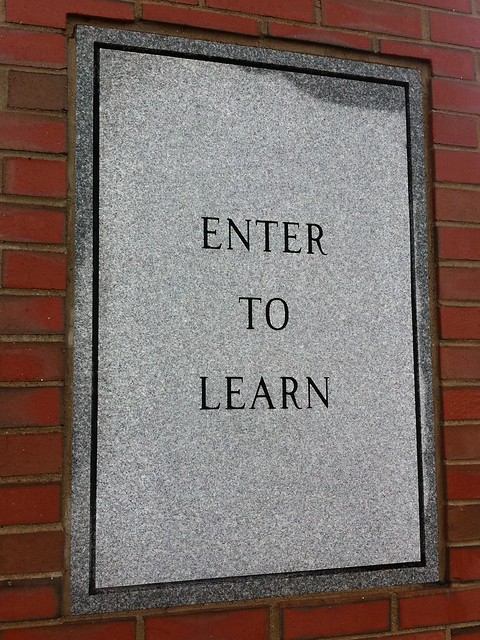
© 2011 Alan Levine, Flickr | CC-BY-SA | via Wylio
In the inductive process, students seek patterns and use them to identify their broader meanings and significance. In the deductive process, meanings or rules are given, and students have to then apply them.
I’m a huge fan of using inductive learning, and plenty of research (which you’ll find in the resources on this list) document its effectiveness.
I’ve written many posts about it, and thought it would be useful to bring together a few of my best ones, along with resources developed by others, that explain the inductive process and how to apply it in mainstream and English Language Learner classrooms (feel free to make suggestions of ones I’ve missed):
The Best Ways To Modify The Picture Word Inductive Model For ELLs
The British Council has shared a short post that Paul Kaye wrote six years ago that does a great job explaining the difference between inductive and deductive, and he provides a number of practical examples from the language-learning classroom. Check out his article, Presenting New Language.
Here are two British Council posts where I wrote about it:
What Does Enhanced Discovery Learning Look Like In The ELL Classroom?
The picture word inductive model
I’ve written several posts at The New York Times explaining the concept:
Ideas for English Language Learners | Labeling Photos, Sequencing Passages and More
Learn About President Kennedy Using the Inductive Model
Learning About New Year’s Inductively
Get Organized Around Assets is an article I wrote for ASCD Educational Leadership. It includes a section on teaching inductively.
The Best Ways To Modify The Picture Word Inductive Model For ELLs
More Info On Why Inductive Learning Is So Effective
”How Google is teaching computers to see” — Inductively
More Research Showing Why Inductive Learning Works
The Picture Word Inductive Model In Science & Social Studies
How to Teach an Inductive Learning Lesson is by Jennifer Gonzalez.
Web 2.0 Tools For Beginning English Language Learners – “Padlet”
Picture Word Inductive Model with High school Newcomers by Wendi Pillars is an exceptional step-by-step description of how to use one of my favorite ELL teaching strategies.
“Thinking Like A Scientist Can Help Overcome Allure Of Appearances”
Study Says Ability To Identify Patterns Key To Second Language Learning
“Szoter” Will Become A Key Tool For ELL Students & Teachers
“Thinglink” Could Be A Great Tool For ELL’s
What Can Teachers Learn From Target?
“We Should Celebrate Mistakes”
This Is The Best Lesson Plan On Punctuation I’ve Ever Read
Is This The Most Important Research Study Of The Year? Maybe
How to Help Our Learners Discover English is from Gallery Languages.
Inductive and deductive grammar teaching: what is it, and does it work? is from the English Language Teaching Global Blog.
Here Are Some Examples Of Using “Concept Attainment” In Writing Instruction
Study: Inductive Learning Promotes “Transfer Of Knowledge” Better Than Direct Instruction
Thinking Inductively: Students focus on A Close Reading of poet Seamus Heaney’s “Blackberry Picking” http://t.co/IKXMu8zssZ
— ReadWriteThink.org (@RWTnow) July 6, 2015
Statistic Of The Day: Employers Want People Who Can “Recognize Patterns”
Surprise, Surprise – New Research Finds Lectures Aren’t The Best Way To Teach
How To Teach With The Concept Attainment Model is from Teach Thought.
Examples Of Student Work From My ELL History Classes
Here’s A New Phonics Activity I Did Today
Teachers Might Find My “Concept Attainment – Plus” Instructional Strategy Useful
Pattern learning key to children’s language development is the headline of a report on a new study. It just reinforces the value of inductive teaching with ELLs.
Here’s good background on the Concept Attainment Model.
More good info on concept attainment.
Two Quick Examples Of Concept Attainment
Why I Love This Strategy to Introduce Concepts is from Middleweb.
This page from Sacramento State University is a good resource on concept attainment.
Guided Discovery in Teaching Essay Writing is from Clare’s ELT Compendium.
How My ELL Students Used Padlet To Create A “Picture Data Set”
Woolly Mammoths & Inductive Learning
I’ve previously posted about the Smithsonian Learning Labs (see Smithsonian Learning Labs Now Lets You Create Free Virtual Classrooms & Assignments). They just shared a great blog post talking about how teachers can create neat online categorization activities for students, and included two different examples.
This is your brain detecting patterns is from Science Daily.
A little labeling goes a long way is from Science Daily. It’s related to labeling and categorizing.
AN OUTLINE FOR HOW STUDENTS CAN LEARN TO WRITE ESSAYS INDUCTIVELY
The Best Resources For Learning About The Value Of “Self-Explanation”
ANOTHER STUDY FINDS ELICITING EXPLANATIONS FROM STUDENTS IS MORE EFFECTIVE THAN TELLING THEM
Frazz explores inductive learning and teaching in today’s comic strip| https://t.co/dMYWiyziV4 https://t.co/MQNUm8WhyY
— Larry Ferlazzo (@Larryferlazzo) April 5, 2020
WEB 2.0 TOOLS FOR BEGINNING ENGLISH LANGUAGE LEARNERS – “CONNECT FOURS”
I REALLY Like This New-To-Me Inductive Learning Strategy
“PuzzGrid” Is An Inductive Learning Excellent Game For ELLs & All Students
An Example Of Concept Attainment & Retrieval Practice In The Classroom
Learning through ‘guided’ play can be as effective as adult-led instruction up to at least age eight is from Science Daily. It sounds like their definition of “play” is inductive teaching and learning.
Sort, Rank, & Justify: The powerhouse instructional strategy you can use for ANY topic https://t.co/3b5zx0EP01
— Amber Teamann (@8Amber8) April 26, 2023
Teaching Math Through Discovery is from Edutopia.
RESOURCES FOR TEACHING PHONICS INDUCTIVELY
Are Inductive Teaching Methods Compatible with Cognitive Load Theory? is an important new study. It’s behind a paywall, but there are ways around that (see The Best Tools For Academic Research).
PADLET UNVEILS COOL NEW AI-POWERED “MAGIC PADLET” FEATURE FOR TEACHERS
Creating a self-directed, student-generated mathematics classroom by Emma Chiappetta from @HumResPro @emmajchiappetta https://t.co/E4AlAfxPgg pic.twitter.com/GbEAWCdbLf
— Raghav Agrawal @impactology@mastodon.social (@impactology) June 18, 2024



Recent Comments